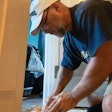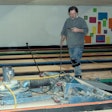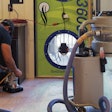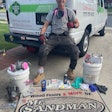
Mold is familiar to all of us. We find it on our bread, in our showers and tubs and on our refrigerator and freezer doors. In fact, it's so common that many of us don't think twice about it. But recently, scientists and medical researchers have found that certain types of mold can pose serious health hazards. Stories about the dangers of mold and homeowners made sick by living in their own homes are pervasive in the media. Of course, these dangerous molds don't endanger only homeowners. They may be found on job sites,putting you and your employees at risk. That's why you need a plan to protect yourself and your workers from this newly recognized environmental threat.
What is mold?
Mold is common in our lives. Like its cousins mushrooms, yeast and mildew, it is a fungus. It can exist almost anywhere and can grow from a few spores to a large colony in just days. The spores are easily dispersed by airborne movement and are a primary method for mold to spread. These spores are an inhalation hazard.
Mold usually is observed as a fuzzy, dark discoloration on organic surfaces such as wood or grout. It frequently is found in wet, moist or humid areas such as bathrooms, basements, kitchens and garages. However, mold can live in a wide range of environments once established. It will establish itself in areas that once were wet, but are now dry,such as locations where water leakage occurred from equipment failure, floods, rain damage or spills. Equipment failures that may trigger a mold infestation include blocked air conditioning unit drains, defrosting freezers or refrigerators, pump or sump back-ups or clogs, leaking windows or roofs,or any structural failure that allows water to dampen environmental surfaces.
The dangerous types of mold
Many types of mold pose no apparent danger to humans. In fact, one of our most useful drugs, penicillin, comes from mold. Roquefort cheese gets its unique flavor from mold. Unfortunately, some molds are hazardous to human health. The danger appears real and serious. Symptoms of toxic mold exposure include asthma, allergic reactions, respiratory problems (including bleeding in the lungs), neurological damage and even death. Children, the elderly and people with damaged or suppressed immune systems are of particular risk. But healthy, robust adults also are susceptible.
The Centers for Disease Control (CDC) estimates there are well over 1,000 types of mold known to science. Some types of mold are dangerous because as they grow they may produce toxins. Currently, the CDC classifies only three types of mold as toxin-producing. A mold type of special concern is Stachybotrys chartarum or atra. This black green mold produces mycotoxins (mycois Latin for mold) that have been linked to pulmonary bleeding and death. It also is suspected of causing memory loss and other serious cognitive damage.
However, science in this area of research is not yet firm. The exact toxins and how they work against human health are not well understood. Consequently, it is prudent to be aware of mold dangers and to protect yourself and your employees from the potential risks. Enormous insurance claims and lawsuits already have been settled over health damage from toxic mold. More claims and suits are being filed daily. Mold toxins can lead to workers' compensation claims and adversely affect a firm's premiums and insurability. Consequently, toxic mold is a health threat and a financial threat to all contractors, flooring installers, finishers and refinishers.
OSHA has not yet developed specific rules to govern mold exposure. However,under the General Duty Clause of the OSHA regulations, employers are required to provide a "safe and healthful workplace" for their employees. Documented instruction in mold dangers and their avoidance is required, and the absence of this safety training could lead to substantial fines.
Specific mold dangers for the flooring industry
Any area in the building, including carpeting, tile, linoleum, other floor coverings, subfloors, baseboards, molding, drywall and other wall materials may harbor toxic mold. Mold is produced by a fungus that requires organic matter in the correct temperature and moisture conditions to flourish. The temperature range in most buildings is ideal for mold growth. Organic materials abound in commercial and residential construction. Wood flooring and baseboards are adequate for mold to colonize. Ample moisture often is present in humid areas, or as a result of facility or equipment malfunctions or spills, as discussed earlier.
Employers should thoroughly inspect all work areas for the presence of mold prior to the start of any work. If a substance suspected to be mold is discovered during the inspection (or later while working), take the following steps immediately:
• Cease all work activity that might spread or disturb the mold
• Leave the infested area
• Inform all other workers, including other companies' employees, and the property owner of the suspected hazard
• Seek professional advice from a safety consultant, industrial hygienist or microbiologist trained in mold identification and remediation.
In no case should flooring workers attempt to remove or clean the mold. Dust masks and latex or nitrile gloves do not offer adequate protection to workers exposed to toxic mold. Solutions of water and chlorine bleach are not effective in "killing" mold. In fact,some mold types may release additional toxins when under attack from cleaning solutions.
Cleaning must be left to a licensed contractor who is specially trained and equipped for such work. Firms that specialize in mold remediation follow many of the same protocols used to clean up asbestos contamination; these professionals certainly view the problem as real and serious. Samples of the mold should be collected and cultured by a specially trained industrial hygienist. This will allow identification of the mold type and an understanding of the level of contamination. Only after the area has been inspected, tested and pronounced safe should any flooring work continue.
If the property owner and other companies working at the site are not informed of suspected mold infestation,your company may be subject to "failure to disclose" legal action resulting in an expensive lawsuit.
Signs of mold infestation in your work site
The owner of the building or home should be consulted regarding any water damage, floods or leaks that may have lead to conditions favorable for mold growth.
• A qualified employee should inspect for mold; it may appear fuzzy, cottony,velvety or leathery and have mixed colors of black, white, green/gray, brown or yellow. Mold often appears as a discoloration, staining or a fuzzy growth on the surface of furniture or walls, ceilings,or anything made of organic substances. Inspect carefully for excess moisture or water damage such as: water leaks near plumbing, doors or windows; standing water; water stains; or condensation problems.
• Carefully inspect areas with noticeable mold odors. Mold often is pungent with an almost sweet, earthy, musty odor.
• Inspect air-handling units, air conditioners and furnaces for stagnant water.
• Inspect behind and underneath materials such as carpeting and pads, all types of flooring, sink cabinets, furniture, boxes, hung pictures or clutter,especially where placed near outside walls or on concrete floors.
Recent controversies
In the past several months, many newspaper and magazine articles have been published that challenge the health threats from mold. These articles describe the evidence that mold is toxic to humans as anecdotal rather than scientific. However, medical science and numerous government agencies, along with the insurance industry, view mold as a very real problem. Caution is warranted and prudent.
The flooring industry employs talented,highly trained artisans. Such employees are the most valuable assets of any company. These employees' health is a primary responsibility of the business owner both legally and morally. The ideas presented briefly here are intended to provide minimal and introductory safety information for usage in flooring industry firms' formal hazard programs.
Stay safe
Good business practices and OSHA regulations require that employers identify workplace hazards and develop safety policies and training programs to protect their workers. Trained and conscientious employees are any company's most valuable asset. Toxic mold is a poorly understood health hazard. However, the consensus is that it poses a serious threat to flooring industry and other construction trades' workers.
Employees should receive documented continuing education both to develop the skills for identifying mold and to recognize that they are not properly trained or equipped to remove it. A thorough mold inspection of the work area is required. When mold is discovered, it must not be disturbed, and qualified consultants should be brought in. Again, commonly used personal protective equipment such as latex or nitrile gloves and dust masks do not provide adequate worker protection from mold.
The property owner must be alerted to the presence of mold to avoid "failure to disclose" lawsuits. Your company has a legal and moral duty to protect both your employees and any other workers or inhabitants of the property from exposure to toxic mold.
There are numerous Web sites that provide color photographs of mold and detailed information on toxic mold protocols. These sites can be used to develop the legally required worker training programs (see "Training and information resources" sidebar below).
Protecting against mold may seem like a hassle, but mold is a health threat that should be taken seriously. As with other proactive training, a little effort on the front end can protect your workers and spare your company lost time and money in the long run.
Training and information resources
Photographs of mold and other valuable in-depth information are available by visiting the following Web sites. These sites and their links may be helpful in formulating a mold hazard policy for your workers and in developing a mold safety manual for training purposes.
inspectapedia.com/mold/Mold-Recognition-Guide.php
Wood flooring in the “Mold Capital”
Wood flooring contractor Bob Bailey of Artisan Hardwood Floors, based in Austin, Texas, remembers an insurance job his company did not that many years ago: “We ripped a floor up, and you could see and smell the mold. It was an extremely bad case; the water had been there for three to four weeks.” What did they do? “We removed the wet, moldy plywood and threw it out. No one called and said they got sick.”
At that time, few people even paused to consider mold a health threat. “We never thought anything about mold,” Bailey continues. “It was just like the old days when we used to sand black mastic off the floor without knowing there was asbestos in it. Until you know the problem exists, how can you address it?”
Fast forward a few years, and the picture is much different. Because Artisan was handling many jobs for people with chemical sensitivities, its workers became more aware of mold’s potential health threat. Mold became a media sensation in Texas and throughout the United States in 2001 when homeowner Melinda Ballard in nearby Dripping Springs, Texas, won a $32 million case against her insurance company for mishandling a mold claim on her 22-room mansion. Artisan was doing so much insurance work and having to pay so much to mold remediation companies that it now has a sister company, Austin Professional Cleaning, that handles mold remediation.
Oftentimes, wood floor contractors are the first ones to encounter a mold situation, Bailey says. A cupped floor means excess moisture, and excess moisture often means mold. Bailey tries to prevent mold problems by handling moisture calls as swiftly as possible. “When we get a call about a cupped floor, we rush out to that job as fast as we can,” Bailey says. “We also tell them to call their insurance adjustor right away, because oftentimes they lollygag, and sheetrock will mold within 48 hours.”
He cautions contractors not to “scream wolf,” however. “It needs to be a very calm, information-collecting process. You need to be aware of how long the floor has been wet and what the source of water is. It also depends on the environment you’re living in. Here in Texas, we live in the mold capital of the world—it’s imperative that we get out and remove that wet flooring.” With the media hype about mold and the successful Ballard lawsuit, insurance adjustors have been cooperative about paying for demolition work, frequently without even seeing the flooring. Artisan workers document such jobs with digital cameras as evidence of the cupped flooring and the ensuing demolition work.
In Bailey’s experience, waiting for a floor to “dry out” simply isn’t realistic, especially given the humid Texas climate and the popularity of slab construction. “In a recessed slab area, even if I could dry the floor successfully … without tearing out the floor, how am I supposed to ensure that the plywood didn’t mold on the bottom?” he asks. Furthermore, homeowners expect to get the problem taken care of immediately. “When it comes to the biggest investment in their life being damaged, they want that addressed now,” Bailey says.
When workers do find what they think is mold (many other things may mimic mold’s appearance), they try to handle it as calmly as possible, Bailey says. They point the mold out to whoever hired them, pull workers off the job, and tell the responsible person that although most molds are harmless, a professional should be brought in to test it—a costly endeavor (reliable tests range from$2,600 to $4,500).
As a wood flooring contractor, there’s a realistic concern that “once you cry ‘mold,’ there’s a chance that the insurance company can dump you,” Bailey cautions, but Artisan has avoided that problem by avoiding an alarmist tone. “We don’t jump up and say, ‘Oh my God, you’ve got mold.’” Regardless of the risk of losing business, contractors have a legal and moral obligation to disclose the problem, he adds.
A simple fact is that many mold problems can be prevented by homeowners simply doing routine maintenance, such as cleaning gutters, making sure sump pumps work and checking basement ventilation. How much of a threat mold actually poses still isn’t clear. What is clear is that with today’s construction, too much moisture can be mold waiting to happen. “We’ve aided and abetted the problem, because now we build a home that’s so energy efficient,” Bailey says. “It’s saving lots of energy, but an airtight house with a leak in it is now a $4.5 million petri dish.” —K.M.W.

































